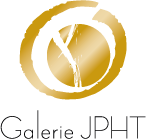Elle ne s’en souvient pas mais Marie-Christine Palombit a dû naitre avec un crayon à la main ! A sept ans, quatorze et seize ans, son talent en herbe est déjà repéré et récompensé lors de salons, concours, festival grâce à sa mère qui n’attend pas l’accord de sa fille pour présenter son travail.
Cette grande timide ne quittera jamais plus crayons et pinceaux pour s’exprimer. Elle trouve la rigueur complémentaire à sa créativité dans l’architecture d’intérieur qu’elle exercera pendant une dizaine d’années jusqu’à ses rencontres avec Ben Ami Koller et Gérard Bignolais qui vont la pousser à présenter son travail dans des galeries et salons. Nous sommes en 1991, et Marie-Christine trace les premiers déliés de la suite de son histoire. Le corps, le mouvement, la femme nourrissent le travail de Marie-Christine. Une évidence pour cette amoureuse des autres qu’ils soient d’ici ou d’ailleurs. Une évidence encore la création, en 2005, de son atelier « ARTCORPUS » aux portes de Paris, à Montreuil. Plus qu’un espace dédié à sa production, il s’agit d’un véritable lieu interactif et foisonnant de créations artistiques, étape incontournable pendant les Portes ouvertes de Montreuil. C’est ici que deux réalisateurs vont filmer l’amplitude et la générosité du geste créatif de Marie-Christine. En 2007, un film de l’INA formation mettant en scène son travail plastique « Faire corps ou le geste créateur » sous la direction de Bernard Monsigny (France 2, Envoyé Spécial, Pro CD, etc.). En 2015, Marcel NAKACHE réalise « A la lumière du geste et du trait » pendant une séance scénographiée où l’artiste réalise avec son modèle ses « Calligraphies organiques ».
Sophie Verchere
Marie Christine Palombit was born in Saint-Denis in 1957. She lives in Sevran, France. In 2005, she worked in Montreuil and created the ARTCORPUS studio conceived like a broad space of creation, self-development, and artistic exchanges. She graduated from Camondo School in 1981 then worked as an interior designer for 10 years before returning to drawing. She exhibited her works for the first time in 1992. She has been teaching for a few years at the Camondo School and the Landscape School (ENSNP) en Blois. In 1994, she produced her first sculptures and took part in graphic performances before a live audience (Off festival in Bobigny, Web bar…). Her graphic and plastic quest revolves around the body as memory and disclosure of feelings. The artist’s first period (from 1992 to 1996) initially figurative and rather classical provides us with twisted, writhing, tormented figures after the manner of E.Schiele.
The following series deliberately seem to move towards an ellipsis of lines to give greater importance to the meaning without giving any keys to the reading. Her works stand on the borders of representational and abstract. The ellipsis of lines is allowed by various techniques (tearing, collage…) using paper and other materials (pigments…) As the artist puts it, it is a way to hush up things, for what is to be depicted partakes of the obvious. The language becomes simpler even if its decoding is not necessarily so, the paintings presenting different layers of interpretation. After a series devoted to the feminine figure with “ îles “(“iles” in English) at the beginning of 1999 and to its masculine counterpart “ îls ” (an alteration of “ ils ” which means “ they ” in English and used when the gender is masculine), she understood an intermediary work on infancy (the ultimate stage of her introspection) between 1999 and 2000 before going on with her work on the body from 2000 to 2001 with series such as “ Jean-Louis ” (a French Christian name), “ Variations Dominique ” (“ Variations about Dominique “ being a French name) and finally “ Suite sur lui ” (“ Suite about him ”). In 2001, Marie-Christine Palombit cast a new light (new energy) on her work with the “ lumières intérieures ”(“ inner lights ”) series which foreshadowed the 2002 and 2003 trend towards bodies on the move with the “ l’homme qui marche ” (“ the walking man ”) series and towards choreographed, radiant, sylphlike bodies on the borders of psychedelic (the “ koregrafi ” series). The body is staged, revealed, bare, it throbs, implodes, is delivered, its legs wide apart…. The artiste seems freed of her demons, not of her obsessions. In 2004 and 2005, she presented us with “ les rouges ” (“ reds ”), a series of representations very close to “ the origin of the world ”, after with “ indigos ” in 2006, procreation, the female womb, her womb, organic life, cellular matter. Almost dissected, in pieces, sequence shots after sequence shots, the body is fingered, torn to bits, split, X-rayed. It is both the container and the contents. It becomes living matter, red, bloody, so human, it is a symbol. The result is almost a product of rough art, it is a return to origins, a rebirth, a life compound.
Aline Geller
